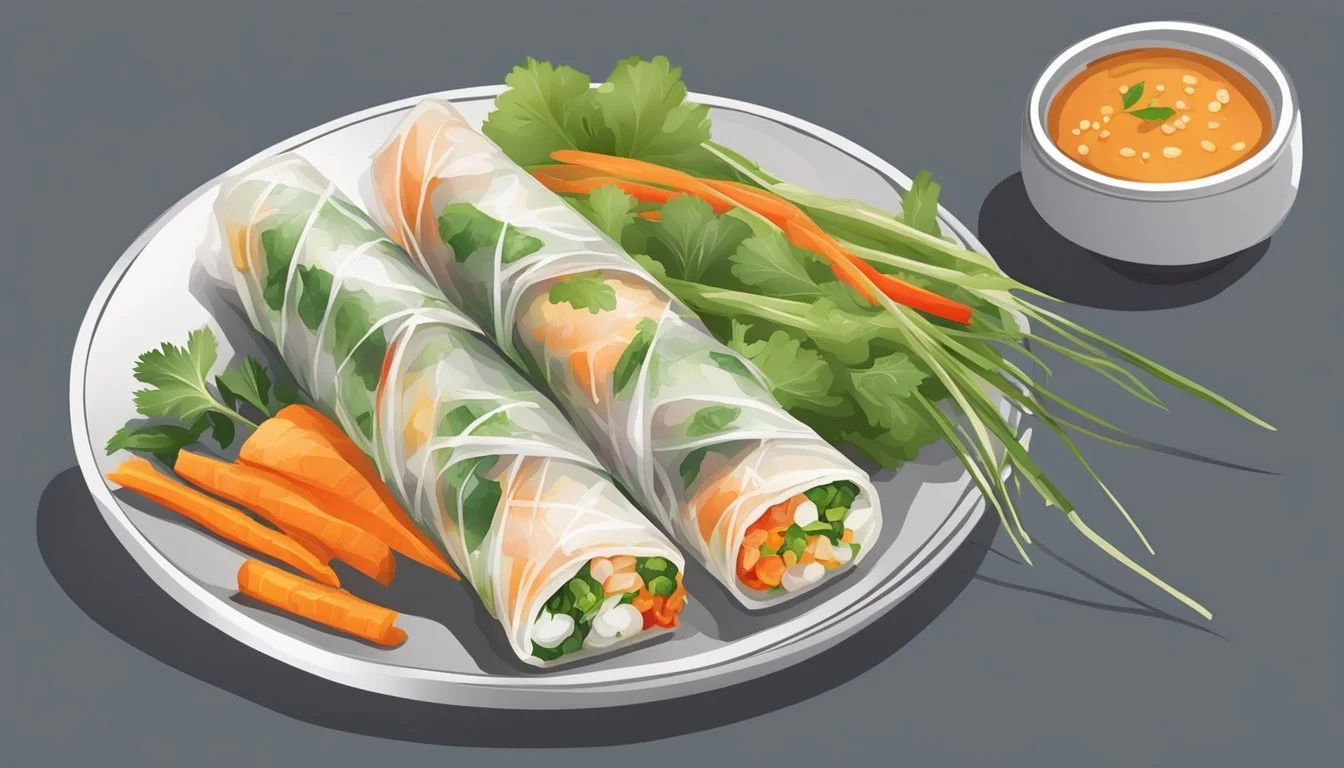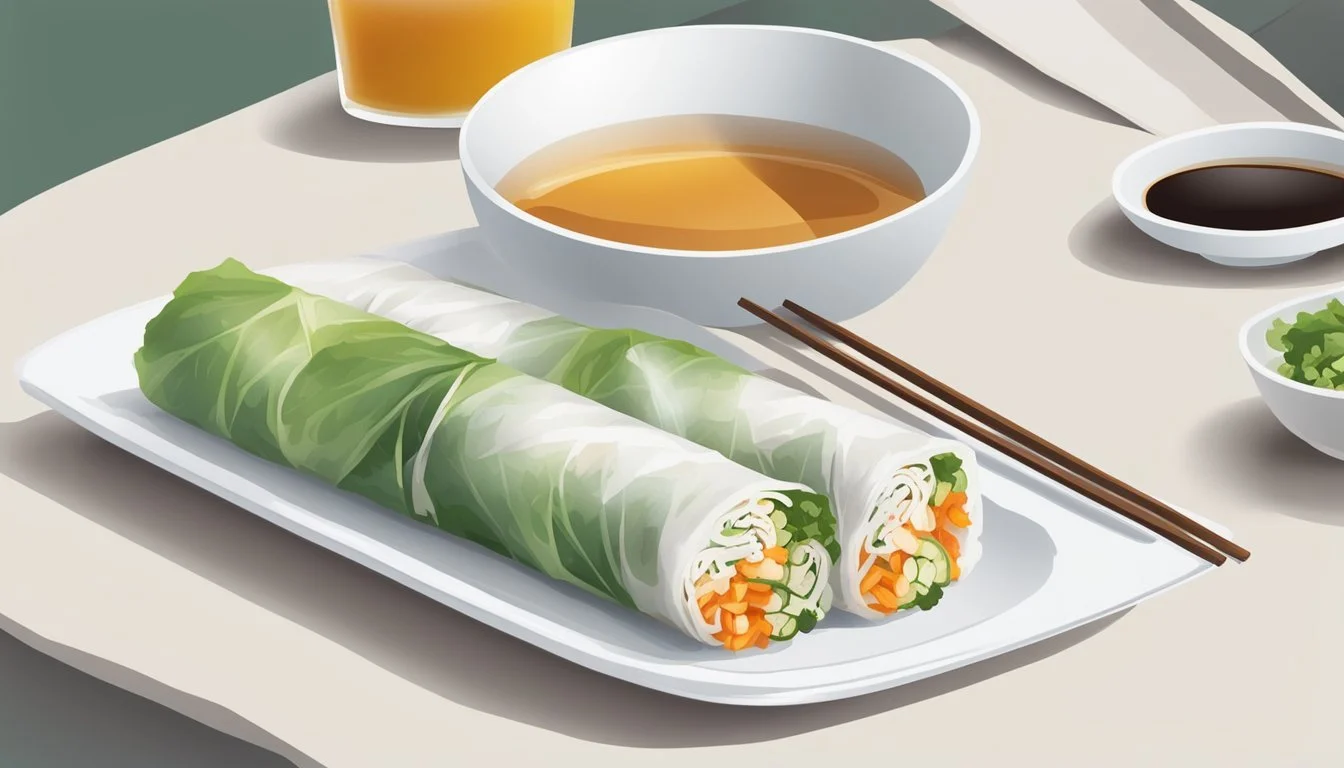How Long Do Fresh Spring Rolls Last?
Shelf Life and Storage Tips
Spring rolls are a popular appetizer, often enjoyed for their fresh, diverse fillings and delicate, translucent wrappers. They are commonly made using rice paper, vegetables, meat, or seafood, and are sometimes confused with egg rolls, which are deep-fried and have a thicker, more dough-like wrapper. Fresh spring rolls (how long do fresh spring rolls last?), also known as summer rolls, present a particular challenge when it comes to storage due to their moisture content and perishable ingredients.
The shelf life of fresh spring rolls is limited and dependent on several factors such as the freshness of the ingredients used, the temperature at which they are stored, and how they are packaged. At room temperature, the rolls tend to last approximately 1-2 hours before the quality begins to decline. If the ambient temperature is especially warm, this window of time may be shorter, due to the increased risk of the ingredients spoiling and the rice paper wrapper becoming hard.
For a longer shelf life, refrigeration can preserve the rolls, maintaining their taste and texture for about 3-4 hours. It’s important to store them properly by covering them with a damp paper towel and sealing them in an airtight container to prevent them from drying out. While it is possible to refrigerate the rolls for up to 24 hours, they are best consumed fresh, as prolonged storage can lead to toughness in the wrappers and noodles within the rolls.
Overview of Fresh Spring Rolls
In the realm of appetizers (What wine goes well with appetizers?) and healthy snacks, fresh spring rolls occupy a special place with their blend of crisp vegetables and other fillings wrapped in delicate rice paper. Not to be confused with their fried counterparts, these rolls are celebrated for their freshness and variety of ingredients.
Defining Fresh Spring Rolls
Fresh spring rolls, also known as summer rolls, are traditional Southeast Asian fare showcasing a combination of fresh vegetables, herbs, and sometimes proteins like shrimp, (What wine goes well with shrimp?) meat, or tofu, all enveloped in a translucent rice paper wrapper. Unlike egg rolls, which are deep-fried, spring rolls are typically served cold or at room temperature, making them a lighter choice.
Popular Ingredients
The beauty of fresh spring rolls lies in their versatility. Common fillings include:
Vegetables: Lettuce, bell peppers, bean sprouts, cucumber, and carrot
Herbs: Cilantro (how long does cilantro last?), mint, basil
Proteins: Shrimp, chicken, or tofu
Noodles: Vermicelli or rice noodles
Many variations might also include ingredients like avocado or cheese to cater to different palates. The common thread among all these ingredients is their emphasis on freshness, aligning with the dish's namesake. The table below lists typical fresh spring roll ingredients:
Category Examples Vegetables Lettuce, cucumber, carrot Herbs Mint, cilantro, basil Proteins Shrimp, chicken, tofu Noodles Vermicelli, rice noodles Wrappers Rice paper
A harmonious blend of these elements, along with the light, slightly chewy wrapper, defines the fresh spring roll's unique character.
Proper Storage Techniques
Storing fresh spring rolls correctly is vital to maintain their freshness and prevent spoilage. From refrigeration to freezing, each method contributes to extending the shelf life of these delicate appetizers.
Refrigeration Guidelines
Fresh spring rolls should be stored in the refrigerator at a temperature at or below 40°F (4°C) to reduce the risk of bacterial growth. To retain moisture, wrap the rolls individually in plastic wrap or place them in a single layer on a plate covered with a damp paper towel, then seal them with aluminum foil or place inside an airtight container. This prevents the rice paper from drying out and maintains the roll's structural integrity. Refrigeration is suitable for short-term storage of up to 24 hours, ensuring optimal freshness.
Wrap each roll individually in plastic.
Place rolls in a single layer, cover with a damp paper towel.
Seal with aluminum foil or store in an airtight container.
Set fridge temperature below 40°F (4°C).
Freezing Methods
Although not ideal due to the delicate nature of rice paper and filling, freezing spring rolls is a possible storage solution for extending the shelf life. To freeze spring rolls, wrap them individually in parchment paper, followed by a layer of plastic wrap or place them in a plastic bag, then store them in the freezer. This method can alter the texture of certain ingredients, like vegetables, so it's less recommended for spring rolls with a high vegetarian content.
Individually wrap rolls in parchment paper.
Encase the wrapped rolls in plastic or a plastic bag.
Alternative Storage Solutions
For additional methods, consider convenience and the type of ingredients used in your spring rolls. If immediate consumption is intended, layered between damp, non-fuzzy lettuce leaves could be a viable way to prevent sticking and maintain moisture without refrigeration for a brief period. However, for best freshness, avoid direct sunlight and warm temperatures to reduce spoilage risk.
Layer rolls between damp lettuce leaves.
Avoid sunlight and warm temperatures.
Maximizing Freshness and Flavor
To ensure that fresh spring rolls retain their crisp texture and flavorful taste, one must consider temperature conditions, the method of handling and cutting, as well as the selection of appropriate ingredients and pairings.
Temperature Considerations
For fresh spring rolls to maintain their desired crispness, they should be stored at cool temperatures. Refrigeration is essential to prevent the rice paper wrappers from drying out and the fillings from spoiling. They should be consumed within 2-3 days to ensure optimal flavor. To avoid drying, the rolls can be covered with a damp cloth before being sealed in an airtight container.
Handling and Cutting Techniques
When preparing spring rolls, it is crucial to handle the delicate rice paper with care to avoid tears that can lead to drying out. Rolls should be cut using a sharp knife to ensure clean cuts without crushing the contents, which can include cooked meats, seafood, vermicelli noodles, and herbs. These cuts not only improve the presentation but also make dipping in sauces easier, enhancing the overall flavor experience.
Ingredients and Pairings
Selecting fresh and high-quality ingredients is vital for maintaining the healthy and tasty profile of spring rolls. A balance of herbs, cooked meats or seafood, and vermicelli noodles contributes to a vibrant and flavorful roll. Pairing the spring rolls with the right dipping sauce—whether it be a tangy fish sauce, a hoisin-peanut blend, or a light soy-ginger sauce—is key to complementing their taste. Subtly flavored oils can be used in the cooking process of meats to add further depth.
Shelf Life Determination
The shelf life of fresh spring rolls is influenced by storage conditions and the freshness of ingredients. Proper identification of freshness and spoilage signs is crucial for safe consumption.
Indications of Freshness
Fresh spring rolls should:
Appearance: Have a clear or slightly opaque wrap with vibrant, fresh-looking fillings.
Smell: Emit no off-putting odors, suggesting that the ingredients inside the cling wrapper retain their quality.
Texture: Feel slightly moist but not soggy, indicating appropriate water content and freshness.
Signs of Spoilage
Spring rolls may be considered spoiled if they exhibit:
Appearance: Discoloration or visible mold suggests bacterial growth.
Smell: A rotten or unusual odor indicates spoilage.
Texture: A mushy or overly moist texture could imply excess water content, making them conducive to bacteria proliferation.
Temperature: High temperatures accelerate spoilage, so spring rolls left out at room temperature for more than 2 hours should be discarded.
Health and Nutritional Information
Fresh spring rolls are often recognized for their nutritional value, which is largely determined by the ingredients used. They can be a healthy choice, especially when packed with a variety of fresh vegetables, lean proteins such as shrimp, and wrapped in a delicate rice paper.
Dietary Benefits
Fresh spring rolls are a rich source of vitamins and nutrients, thanks to the inclusion of fresh veggies like lettuce, cucumbers, and bean sprouts, and herbs such as cilantro. Vegetarian options that include jicama and avocado provide beneficial fats and fiber. For those including shrimp, it adds a good source of protein without significantly increasing calorie content. Rice noodles, often found in spring rolls, are a great gluten-free carbohydrate source. When prepared with minimal use of oil, or with healthy options like olive oil, spring rolls can be a low-calorie, nutritious addition to a diet.
Comparing Spring Roll Varieties
When compared to their deep-fried counterpart, the egg roll, fresh spring rolls are healthier due to their method of preparation — they are not fried, hence have less fat and calories. Here's a comparison for clarity:
Calories: Spring rolls range from 80 to 110 calories each, whereas an average vegetable-filled egg roll contains about 153 calories.
Preparation: Egg rolls are fried, contributing to a higher fat content, while spring rolls avoid the use of excess oil.
Ingredients: Fresh spring rolls often contain a higher quantity of fresh ingredients like herbs and veggies, contributing to higher nutritional content.
Preparation and Serving Suggestions
When crafting fresh spring rolls, one should focus on fresh ingredients and proper assembly for optimal taste. They are versatile and can accommodate various fillings and dipping sauces to suit personal preferences.
Making Fresh Spring Rolls
To make fresh spring rolls, gather ingredients such as rice paper wrappers, butter lettuce, mint leaves, basil (how long does basil last?) leaves, sliced bell peppers, and vermicelli noodles. The process is akin to wrapping a burrito:
Softening the Wrappers: Dip rice paper wrappers in lukewarm water for just 20 seconds until they become flexible.
Layering the Fillings: On the softened wrapper, place a layer of butter lettuce and add a combination of herbs, veggies, and noodles. Fresh herbs like mint and basil add a burst of flavor.
Rolling Techniques: Carefully pull the bottom of the wrapper over the filling, fold in the sides, and then roll tightly. A moistened tea towel can prevent them from drying out.
Serving and Presentation
Fresh spring rolls should be served immediately at room temperature for the best texture and taste:
Cutting: Slice each roll in half diagonally and arrange on a plate showcasing the vibrant cross-section.
Plating: Place the rolls on a clean plate with some space between each to avoid sticking.
Creating Dipping Sauces
Dipping sauces can range from spicy to sweet, but a creamy peanut dipping sauce is a classic choice. Here's a simplified recipe:
Ingredients: Combine crushed peanuts, a hint of salt, and a touch of sweetness in a creamy base.
Consistency: Aim for a consistency that’s thick enough to cling to the rolls but fluid enough for easy dipping.







